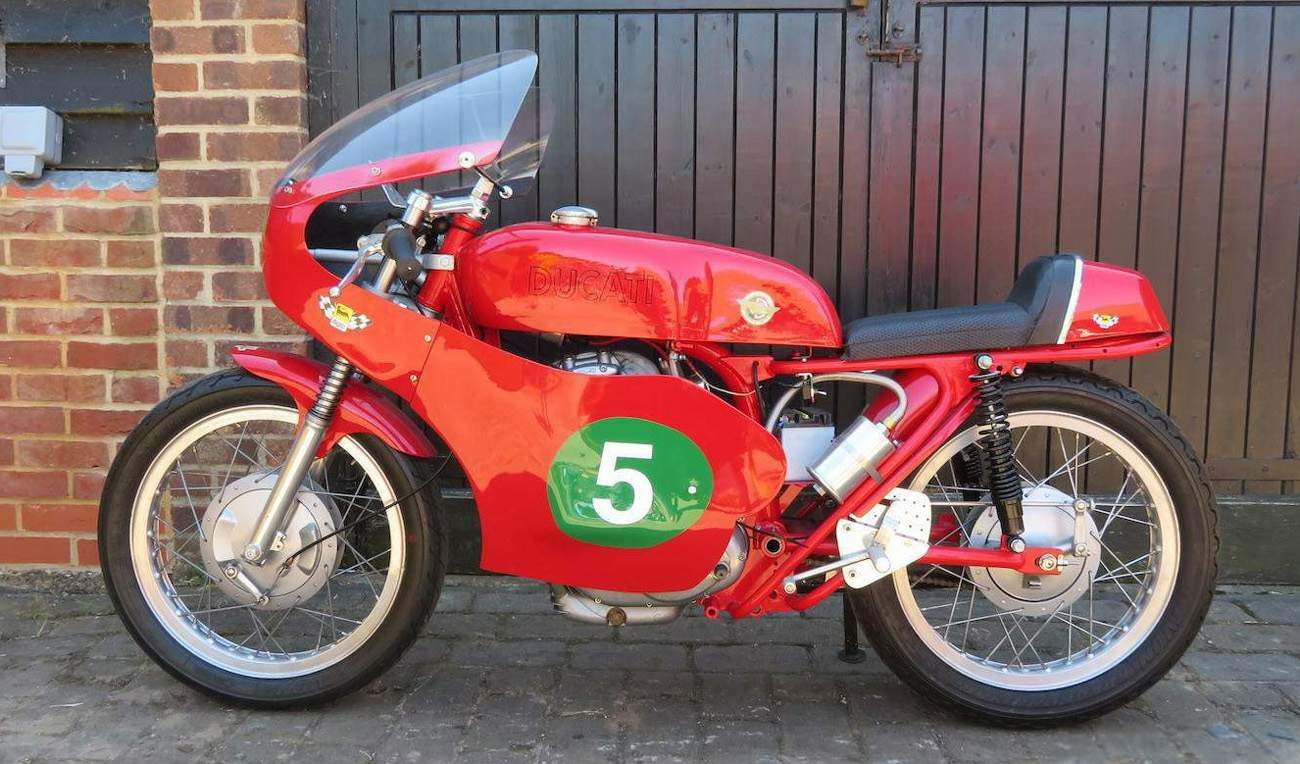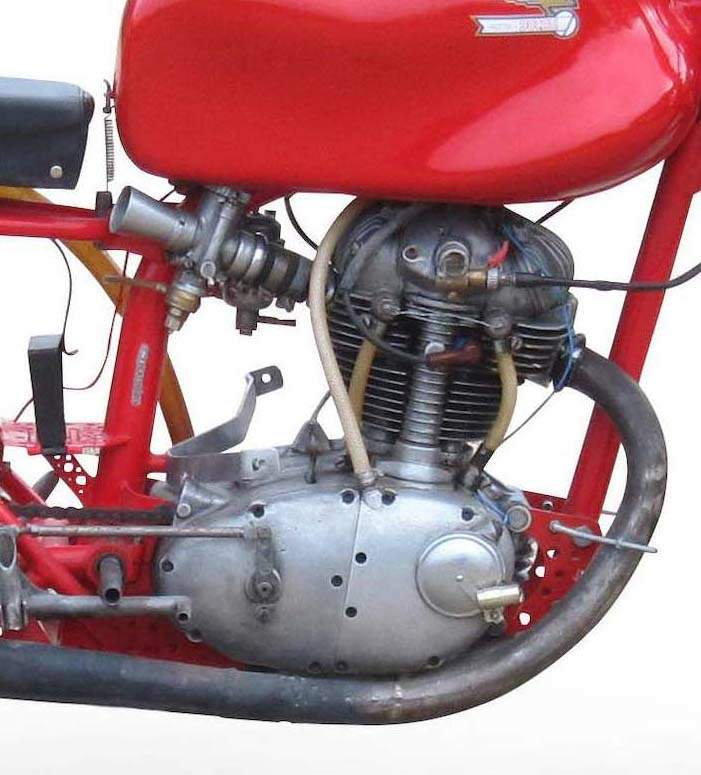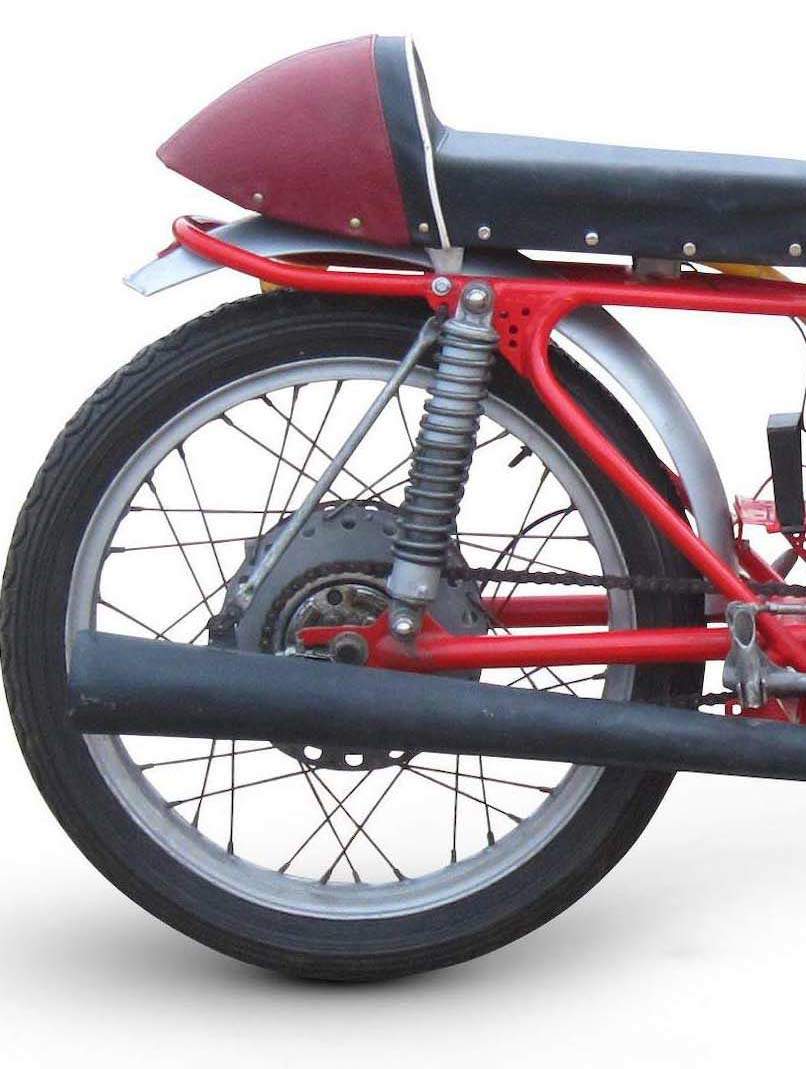
|
|
|
|
|
|
Classic Bikes
Custom Bikes
Individual
Racing Bikes AJP
AJS
Aprilia
Ariel
Avinton / Wakan
Bajaj
Benelli
Beta
Bimota
BMW
Brough Superior
BRP Cam-Am
BSA
Buell / EBR
Bultaco
Cagiva
Campagna
CCM
CF Moto
Combat Motors
Derbi
Deus
Ducati
Excelsior
GASGAS
Ghezzi Brian
Gilera
GIMA
Harley Davidson
Hero
Highland
Honda
Horex
Husaberg
Husqvarna
Hyosung
Indian
Jawa
Kawasaki
KTM
KYMCO
Laverda
Lazareth
Magni
Maico
Mash
Matchless
Mondial
Moto Guzzi
Moto Morini
MV Agusta
MZ / MuZ
NCR
Norton
NSU
Paton
Peugeot
Piaggio
Revival Cycles
Roland Sands
Royal Enfield
Sachs
Sherco
Sunbeam
Suzuki
SWM
SYM
Triumph
TVS
Ural
Velocette
Vespa
Victory
Vincent
VOR
Voxan
Vyrus
Walt Siegl
Walz
Wrenchmonkees
Wunderlich
XTR / Radical
Yamaha
Zero
Video
Technical
Complete Manufacturer List
|
Ducati 250 F3 Production Racer |
| . |
Designed by Fabio Taglioni, Ducati's first overhead-camshaft single - the 100 Gran Sport - appeared on the racetrack in 1954 and soon proved unbeatable in its class.
A pair of 175cc roadsters was introduced for the 1956 season, the sports version of which was capable of more than 80mph, an astonishing achievement at the time and one that helped establish the 'giant killing' reputation long enjoyed by Ducati's miniature masterpieces. In 1959 the engine capacity was increased to 204cc for the Elite and 200SS models, and then in 1961 came the first road-going '250', the Diana.
Developed from a successful production racer, the sporting newcomer sold as the 'Daytona' in the UK and could be ordered with a race kit for track use. The kit boosted engine power and raised top speed from 84mph to the magic 'ton', demonstrating a potential for further development that would be fully realised by the Daytona's successor: the legendary Mach I.

Overview
Ducati's rise to a global brand and racing success began when Ducati Meccanica's
first director, Dr Giuseppe Montano, persuaded the legendary Fabio Taglioni to
join the factory in May 1954. Taglioni had worked for two companies before
joining Ducati, showing a flair for designing lightweight engines that could win
the important "Gran Fondo" (large fund, i.e. big prize money) races. The most
important before the Second World War had been the Milano Taranto, a near
thousand-mile dash from Milan down Italy's east coast.
But throughout the 1950s it was a revitalised Motogiro d'Italia that captured
the public imagination. This race was run over several daily stages to gain the
maximum publicity, with entries restricted to motorcycles closely related to
ones the public could buy. Nothing larger than 175cc was allowed, again
reflecting what was selling.
Taglioni's first design for a Gran Fondo racer had been a 75cc single
manufactured and raced under the Ceccato name. His next was with Mondial,
working on desmodromics and 175s that won both the Milano Taranto and Moto Giro
in 1954, the only time a manufacturer was victorious in both races in the same
year. When Taglioni wasn't invited to Mondial's celebrations he quietly cleared
his desk and left. He could have had a steady salary at anywhere from Ford to
Ferrari, but chose Ducati simply because he was promised the autonomy necessary
to build world class racing motorcycles.

Success in the Motogiro quickly came to mean success in the showrooms, so
Ducati's failure to achieve a single in the 1953 and 1954 events had weighed
heavily on Montana's mind. Unsurprisingly Taglioni's initial focus was on the
urgent need for a new motorcycle that could survive, and ideally win, the
gruelling road race.
Taglioni's first offering was the Gran Sport, a 99.66cc single with what would
become Ducati's trademark bevel and shaft driven overhead camshaft. Laverda
immediately protested that the Gran Sport wasn't a true production bike, but
rather a dedicated, hand-built, racer that the competitions' pushrod overhead
valve models would have no chance against.
In truth Laverda had a point. Even though the Gran Sport did eventually go into
production, it was in limited numbers, and at a price that reflected its
complexity and the expertise required during assembly. Nonetheless the 1955
Motogiro made Montana a very happy man when the new Gran Sport took every place
bar one in the 100cc class. One even managed fifth overall, beating a great many
175cc machines.
Building on this success Taglioni immediately planned an enlarged Gran Sport by
upping the engine's bore to 55.25mm. The resulting 125cc motor proved even more
dominant with Giuliano Maoggi taking the new motorcycle to victory in the 125cc
class of the Milano Taranto a few months later. He would then take the Ducati to
overall victory in the 1956 Motogiro.

Whilst the bevel singles went into production as sporting ride to work machines,
Ducati also offered for sale a new racing 125, the F3. This bore little relation
to the production models, being a hand built motorcycle in the mould of the Gran
Sport, with sandcast engine components and specialist cycle parts that meant
little was interchangeable with its road going cousin.
Inevitably a 175cc version of the F3, but outside Italy the 175 class was rarely
considered important. When Michel Barone won the 1960 250cc French Championship
on a prototype 250 Ducati single, it was inevitable that production and F3
racing versions would follow.
Only available in 1961 and 1962, the 250F3 (sold by UK importer Vic Camp as the
Manxman) had a sandcast motor that carried over the 175's ribbed conrod and
longer, stepped, crankshaft. Unlike previous F3s the 250's head incorporated
bosses to allow desmo closing rockers to be fitted, and at least one left the
factory so equipped. The clutch cover also omitted an inspection cover and
drilling to allow a kick starter. While the bore and stroke were the same as the
roadster, at 74 x 57.8mm to give 248.6cc, the carburettor was a 29mm Dell'Orto
SSi 29A (rather than 27mm). The frame was unique to the 250F3, and the cycle
parts were very different to the roadsters: for example, the F3 featured 19" –
rather than 18" – wheels.
On the 11 August 1962 Campbell Donaghy finished the 250cc class of the Ulster
Grand Prix – then a round of the world championship - in fifth place on an F3
Manxman, gifting Ducati their first ever world championship points for a 250
single. Three works Hondas finished ahead of Donaghy, followed by Arthur
Wheeler's famous Moto Guzzi, making the achievement all the more remarkable.

|
Any corrections or more information on these motorcycles will be kindly appreciated. |